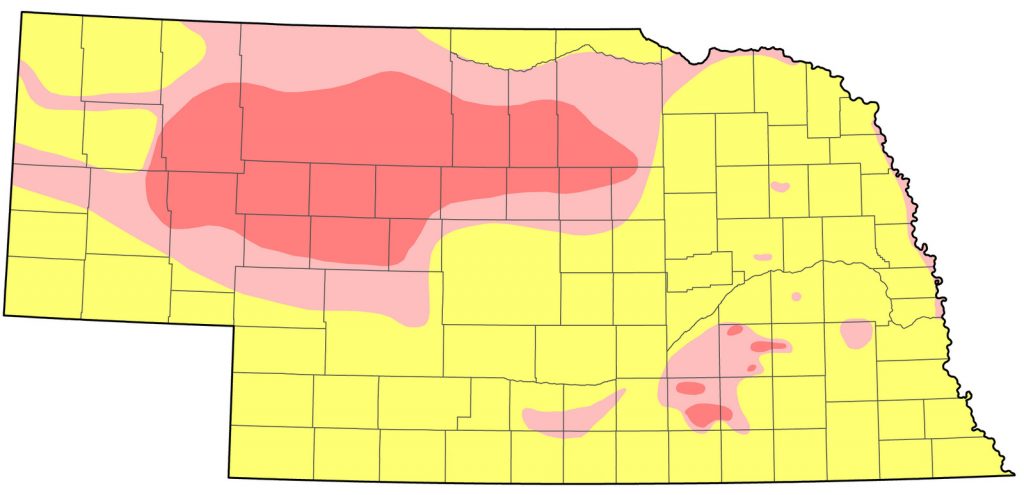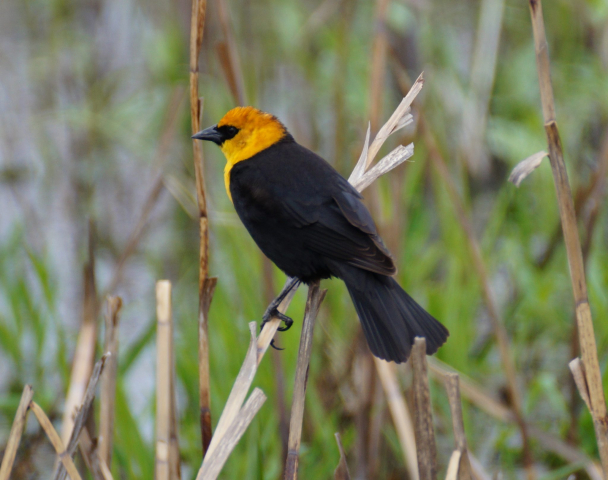Xanthocephalus xanthocephalus
Status: Common, locally abundant, regular spring and fall migrant statewide. Common breeder north-central and west, locally fairly common east and south. Rare casual winter visitor statewide.

Documentation: Specimen: UNSM ZM6964, 18 May 1901 Nebraska City, Otoe Co.
Taxonomy: No subspecies are recognized (AviList 2025).
Spring: Feb 15, 16, 17 <<<>>> summer
Earlier dates are 10 Feb 2023 Jack Sinn WMA, Lancaster Co, and 12-15 Feb 2021 at a feeder Platte Co.
Earliest arrivals are usually single males, which sometimes appear by mid-Feb with Red-winged Blackbird flocks. One was early on territory at Hyannis, Grant Co 8 Mar 2013. The species is generally rare until mid-Mar, but by mid-late Apr numbers increase markedly and the species is usually observed in single-species flocks. Peak numbers occur in mid-Apr. Late flocks are sometimes seen; 1000 were in the eastern Rainwater Basin 4 May 1997, and 200 immatures were in a flock 25 May 1997 near Funk WPA, Phelps Co.
- High counts: 10,000 at Funk WPA 19 Apr 1998, 2050 at Smartweed Marsh WMA, Nuckolls Co 16 Apr 2021, 2000 at Clear Creek WMA, Garden Co 22 Apr 1995 and “several thousand” in the eastern Rainwater Basin 20 Apr 2001.
Summer: Breeds in deeper marshes with emergent vegetation such as cattails (Typha spp.) or bulrush (Scirpus sp.) and thus its breeding distribution matches the distribution of this habitat type in the state (Mollhoff 2016). Highest densities occur in the Sandhills (Sauer et al 2017); 3000 were at Crescent Lake NWR, Garden Co 30 Aug 1998 and 400 were at Goose Lake, Crescent Lake NWR 9 Jun 2021.
Lower breeding numbers occur elsewhere in Nebraska, although from year-to-year numbers are variable and the species may be absent altogether depending on water conditions (Blake and Ducey 1991, Jorgensen 2012). The species can also rapidly colonize formerly dry sites, such as those in the Rainwater Basin, following heavy rains that fill wetlands (Jorgensen 2016).
It occupies deeper areas of the marshes and actively excludes Red-winged Blackbirds from those areas (Twedt and Crawford 2020).
- Breeding phenology:
Nest-building: 26 May
Eggs 4 May- 27 Jul (Mollhoff 2022)
Nestlings: 2 Jun- 4 Jul
Fledglings: 11 Jun- 31 Jul
Mollhoff (2004) noted nesting underway almost synchronously across the state in 2002.
- High counts: 310 at Crescent Lake NWR, Garden Co 11 Jun 2024.
Fall: summer <<<>>> Nov 22, 23, 24
There are several scattered later dates, including CBC data (see Winter).
Large flocks of molting birds occur at favored localities during Jul-early Aug, such as at Lake Ogallala, Keith Co 1989 and 1990 (Brown et al 2012); 410 were in a flock at Oliver Reservoir, Kimball Co 21 Jul 2025. Most fall migrants leave the state by late Oct, with expected last dates in early Nov.
Rosche (1994) noted that a major fall staging area is the marshes at the west end of Lake McConaughy, where 2000-3000 were present 10 Sep 1988.
- High counts: 4800 at Whitney Lake, Dawes Co 1 Sep 2021, 2000-3000 at Lake McConaughy 10 Sep 1988, 2700 at Oliver Reservoir, Kimball Co 6 Sep 2024, and 1500 at Lake McConaughy 12 and 13 Sep 2013.
Winter: The only documented records of overwintering include a single at a feeder at Crescent Lake NWR, Garden Co 9 Dec-21 Feb 1980-81 (Williams 1981), one at Ogallala, Keith Co 1993-94 (Rosche 1994), two males and a female at a feedlot east of Gering, Scotts Bluff Co 2000-2001, and one that survived at a Platte Co feeder with Red-winged Blackbirds 2012-2013 (a second bird was predated by a Cooper’s Hawk).
There are 27 additional winter reports spaced out evenly 25 Nov-9 Feb: two in Nov, 10 in Dec, five in Jan, and two in Feb. Latest are 13 Jan 2018 Lancaster Co, 27 Jan 2021 Hall Co, 1 Feb 2021 Keith Co, and 4 Feb 2025 Holt Co. West and west central reports are 29 Nov 1998 (2) Keith Co, 14 Dec 2015 Dawson Co, 15 Dec 2024 Sioux Co, 20 Dec 2018 Keith Co, and 1 Feb 2021 Keith Co.
A surprising flock of 100 was in Cedar Co 18 Dec 2022, and there were counts of eight on the Scottsbluff CBC 14 Dec 2003, six on the DeSoto NWR CBC, Washington Co 22 Dec 1979, and five at DeSoto NWR 20 Dec 1981. Singles were westerly in Lincoln Co 20 Dec 2020 and Kimball Co 9 Jan 2021.
Images
Abbreviations
CBC: Christmas Bird Count
NWR: National Wildlife Refuge
UNSM: University of Nebraska State Museum
WMA: Wildlife Management Area (State)
WPA: Waterfowl Production Area (Federal)
Literature Cited
AviList Core Team, 2025. AviList: The Global Avian Checklist, v2025. https://doi.org/10.2173/avilist.v2025.
Blake, L., and J. E. Ducey. 1991. Birds of the eastern Sandhills in Holt County, Nebraska. NBR 59: 103-132.
Brown, M.B., S.J. Dinsmore, and C.R. Brown. 2012. Birds of Southwestern Nebraska. Conservation and Survey Division, Institute of Agriculture and Natural Resources, University of Nebraska—Lincoln, Lincoln, Nebraska, USA.
Jorgensen, J.G. 2012. Birds of the Rainwater Basin, Nebraska. Nebraska Game and Parks Commission, Lincoln, Nebraska, USA.
Jorgensen, J.G. 2016. A summary of 2015 breeding bird surveys of selected Rainwater Basin wetlands. Nongame Bird Program of the Nebraska Game and Parks Commission, Lincoln, Nebraska, USA.
Mollhoff, W.J. 2004. The 2002 Nebraska Nesting Report. NBR 72: 153-158.
Mollhoff, W.J. 2016. The Second Nebraska Breeding Bird Atlas. Bull. Univ. Nebraska State Museum Vol 29. University of Nebraska State Museum, Lincoln, Nebraska, USA.
Mollhoff, W.J. 2022. Nest records of Nebraska birds. Nebraska Ornithologists’ Union Occasional Paper Number 9.
Rosche, R.C. 1994. Birds of the Lake McConaughy area and the North Platte River valley, Nebraska. Published by the author, Chadron, Nebraska, USA.
Sauer, J.R., D.K. Niven, J.E. Hines, D.J. Ziolkowski, Jr, K.L. Pardieck, J.E. Fallon, and W.A. Link. 2017. The North American Breeding Bird Survey, Results and Analysis 1966 – 2015 (Nebraska). Version 2.07. USGS Patuxent Wildlife Research Center, Laurel, Maryland, USA.
Twedt, D.J. and R.D. Crawford. 2020. Yellow-headed Blackbird (Xanthocephalus xanthocephalus), version 1.0. In Birds of the World (A. F. Poole and F. B. Gill, Editors). Cornell Lab of Ornithology, Ithaca, NY, USA. https://doi.org/10.2173/bow.yehbla.01
Williams, F. 1981. Southern Great Plains Region. American Birds 35: 198-201.
Recommended Citation
Silcock, W.R., and J.G. Jorgensen. 2025. Yellow-headed Blackbird (Xanthocephalus xanthocephalus). In Birds of Nebraska — Online. www.BirdsofNebraska.org
Birds of Nebraska – Online
Updated 30 Aug 2025

